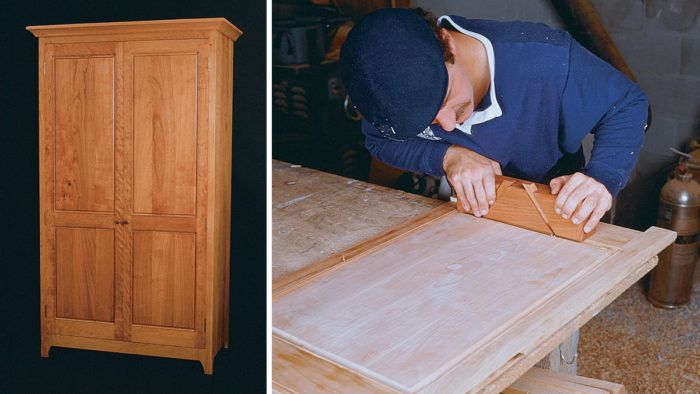Building a Shaker-Style Wardrobe
Beads and crown dress up a basic cabinet
Synopsis: Tom Hagood sought to find a traditional wardrobe design that allowed some creative interpretation for his own design details. In order for it to fit his client’s needs, he made a perspective sketch of the room before deciding on the proportions of his wardrobe, which ended up being 72 in. tall, 42 in. wide and 22 in. deep. He made a jig to help cut the mortises in the bottom of the sides in the carcase construction, and also explains how he built the doors and crown molding. A project plan gives dimensions.
I’ve never been especially fond of period furniture; therefore, the commission I received to build a traditionally styled wardrobe cabinet was quite a challenge. The client did not specify the style, but the piece had to fit into an Early American bedroom dominated by a huge antique mahogany bed—a family heirloom. Because all my previous work had been with contemporary designs, I had some reservations about accepting the commission; a contemporary wardrobe would clearly be out of place in this bedroom. Thus, I set out to find a period style that would be traditional yet allow for some creative interpretation so I could incorporate my own design details. In this article, I’ll tell you how I developed my design, worked out the details and built the cherry wardrobe cabinet pictured at right.
Before I began designing the wardrobe, I searched through furniture reference books for a period piece to serve as a point of departure. In my search, I discovered a reference book called Chests, Cupboards, Desks and Other Pieces by William C. Ketchum, Jr. (published by Random House, Westminster, Md. 21157). Although primarily a book for furniture collectors, I find it a valuable resource for furniture designers: The book includes photographs and drawings of a dizzying number of styles, from English and French period pieces to Shaker designs to Wendell Castle stack-laminated work. The book even includes joinery details and dimensions for many of the pieces.
Ketchum’s book contains a photo of a simple Shaker wardrobe that seemed to fit my needs. The piece is traditional looking yet plain enough to benefit from the addition of some of my decorative details. I was already somewhat familiar with Shaker furniture and crafts, having at one time manufactured Shaker-style steambent oval boxes, and I like the Shakers’ straightforward, functional approach to furnituremaking. There are also modern interpretations of the style that I like, such as the work of furnituremaker Thomas Moser of Maine.
It was necessary to adapt the dimensions of the wardrobe to fit the client’s room and accommodate the amount of clothing the cabinet would have to hold. To help visualize how the cabinet would relate to its surroundings, I made a perspective sketch of the room, including a view of the ceiling and other bedroom furnishings. I chose to make the wardrobe 78 in. tall and 42 in. wide to fit harmoniously with the client’s large bed, and I made the wardrobe 22 in. deep to easily handle bulky winter clothes hung on a clothing pole inside.
Pleased with the proportions of the cabinet, I went back to the drafting table to work out the small details, such as the cutout base beading around the door frames, the profile of the crown molding and the joinery to hold the cabinet together.
From Fine Woodworking #74
For the full article, download the PDF below:
Fine Woodworking Recommended Products

Stanley Powerlock 16-ft. tape measure


Compass






















Log in or create an account to post a comment.
Sign up Log in